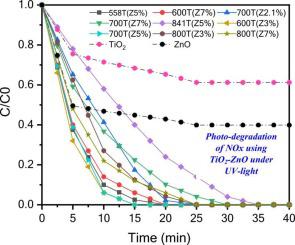Journal of Environmental Chemical Engineering ( IF 7.4 ) Pub Date : 2021-09-22 , DOI: 10.1016/j.jece.2021.106417 Kabuyaya Kighuta 1, 2 , Anantha-Iyengar Gopalan 3 , Dong-Eun Lee 3 , Gopalan Saianand 4 , Yao-Long Hou 5 , Sung-Sik Park 1 , Kwang-Pill Lee 2 , Jun-Cheol Lee 6 , Wha-Jung Kim 2

|
The major focus of this work is the design and optimization of the preparation conditions of binary titanium dioxide-zinc oxide (TiO2-ZnO) composite using response surface methodology (RSM). Calcination temperature and ZnO weight percent (%) with respect to TiO2 were chosen as the key parameters for optimizing the preparation conditions. The evaluation of photocatalytic nitrogen oxides (NOx) removal efficiency was selected for modeling the RSM. Thirteen factorial design runs were first generated with one replicate and 5 center points in order to perform all the experiments. The experimental results on NOx removal efficiency for the composites calcined at 747, 602, and 558°C containing 5.48%, 3.48%, and 2.1% of ZnO with respect to the weight of TiO2, designated as MaxT(Z%), MedT(Z%) and MinT(Z%) respectively, agree well with RSM predictions. The response coefficient difference between experimental and RSM results of MaxT(Z%), MedT(Z%), and MinT(Z%) were approximately 0.019, 0.044, and 0.11, respectively. The microstructural and optical properties as well the surface composition of MaxT(Z%), MedT(Z%), and MinT(Z%) were evaluated by X-ray diffraction (XRD), diffuse reflectance spectroscopy (DRS), and X-ray photoelectron spectroscopy (XPS), respectively. The results from the photodecomposition of NOx gas under illuminated UV-light confirmed that the TiO2-ZnO prepared with a 2.1 weight % of ZnO and calcined at 558°C witnessed the best photocatalytic activity and the reasons for the excellent performance are corroborated with XRD, XPS, and DRS results. This study provides a simple and systematic approach for the optimization and modeling of the binary composite preparation for achieving enhanced photoactivity.
中文翻译:

响应面法优化光催化TiO2-ZnO复合材料制备参数的优化与建模
这项工作的主要重点是使用响应面法(RSM)设计和优化二氧化钛-氧化锌(TiO 2 -ZnO)复合材料的制备条件。选择煅烧温度和 ZnO 相对于 TiO 2 的重量百分比 (%)作为优化制备条件的关键参数。选择光催化氮氧化物 (NO x ) 去除效率的评估来模拟 RSM。为了执行所有实验,首先生成了具有 1 个重复和 5 个中心点的 13 个因子设计运行。NO x的实验结果在 747、602 和 558°C 下煅烧的复合材料的去除效率,其中含有 5.48%、3.48% 和 2.1% 的 ZnO(相对于 TiO 2的重量),指定为 MaxT(Z%)、MedT(Z%) 和MinT(Z%) 分别与 RSM 预测一致。MaxT(Z%)、MedT(Z%) 和 MinT(Z%) 的实验和 RSM 结果之间的响应系数差异分别约为 0.019、0.044 和 0.11。通过 X 射线衍射 (XRD)、漫反射光谱 (DRS) 和 X-射线光电子能谱(XPS),分别。NO x气体在紫外光照射下的光分解结果证实,TiO 2用 2.1 重量%的 ZnO 制备并在 558°C 下煅烧的 -ZnO 见证了最佳的光催化活性,其优异性能的原因得到了 XRD、XPS 和 DRS 结果的证实。该研究为二元复合制剂的优化和建模提供了一种简单而系统的方法,以实现增强的光活性。











































 京公网安备 11010802027423号
京公网安备 11010802027423号